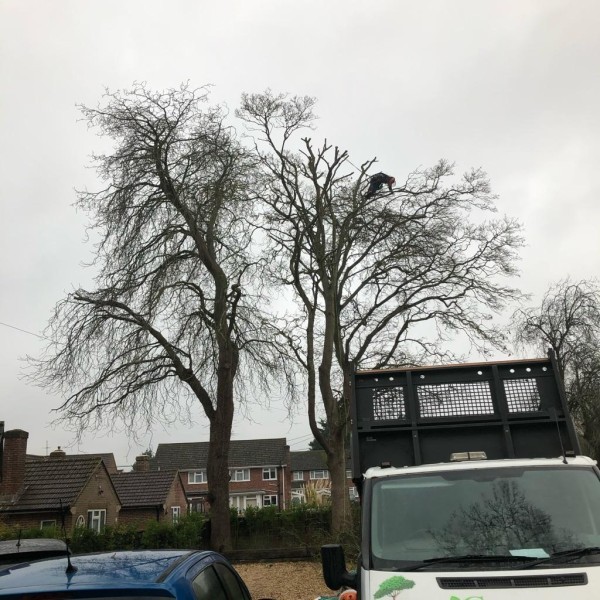Tree Surgeons in the UK
Welcome to SKR Specialist Services Ltd, your go-to experts for all your renovation and property needs in Kimberworth Park and the wider S... read more »
Welcome to Premier Estates Home Improvements, your go-to experts in Ettingshall for all your building and landscaping needs. As a leading... read more »
Brian Hill Landscaping: Your Premier Landscaping Experts in Barrow Hill, Derbyshire
Welcome to Brian Hill Landsc... read more »
Welcome to Bigfellaz Property Maintenance, your premier choice for top-notch property maintenance services in Smite Hill and throughout W... read more »
H20 Roofing and Building Ltd: Premier Tradespeople in Berkshire
Welcome to H20 Roofing and Building Ltd, your trus... read more »
Oakland’s Landscapes Ltd is a premier choice for all your building and landscaping needs in Newyears Greenread more »
Welcome to WR Tree and Landscapes, your trusted driveway and landscaping contractors in Woodvale, Merseyside. We specialise in transformi... read more »
Isaacs Tree And Garden Services, based in Horninglow, is your go-to solution for all landscaping and garden needs in Sta... read more »
Welcome to Greenacre, your trusted partner for exceptional landscaping services in Gildersome Street and throughout West Yorkshire. As le... read more »
ACE Property Maintenance is a premier service provider based in West Yoke, offering a comprehensive ran... read more »
Welcome to R A Civils Limited, your trusted partner for exceptional landscaping and groundwork services in South Stour and throughout Ken... read more »
Welcome to Four Seasons Property Maintenance, your go-to experts for comprehensive property maintenance services in Newtown, Ch... read more »
Welcome to Herder Construction, your go-to experts for all your construction and landscaping needs in Stilton and across the beautiful co... read more »
Stormproof Roofing And Painting is your go-to solution for all your home improvement needs in Harraby and across the bea... read more »
Stemma Tree Care: Expert Tree Surgeons in Renfrewshire
Welcome to Stemma Tree Care, your trusted tree surgeons b... read more »
Welcome to Trinitee Ltd, your trusted partner for all your roofing needs in Folkestone and ac... read more »
Green-Leaf Tree & Landscapes is a premier choice for landscaping and tree surgery services in East Grimsteadread more »
Welcome to Oakfern, your go-to experts for Landscaping Contractors, Tree Surgeons, Driveway Contractors, Patio Contractors, and Block Pav... read more »
Welcome to Evergreen Tree & Landscaping Services, your premier choice for expert tree surgeons in Hextable, proudly serving the entire co... read more »
Nationwide Tree Care and Landscaping is your go-to expert for landscaping contractors and tree... read more »
Search Tree Surgeons by county
- Tree Surgeons in London
- Tree Surgeons in Bedfordshire
- Tree Surgeons in Berkshire
- Tree Surgeons in Bristol
- Tree Surgeons in Buckinghamshire
- Tree Surgeons in Cambridgeshire
- Tree Surgeons in Cheshire
- Tree Surgeons in Cornwall
- Tree Surgeons in County Durham
- Tree Surgeons in Cumbria
- Tree Surgeons in Derbyshire
- Tree Surgeons in Devon
- Tree Surgeons in Dorset
- Tree Surgeons in East Riding of Yorkshire
- Tree Surgeons in East Sussex
- Tree Surgeons in Essex
- Tree Surgeons in Gloucestershire
- Tree Surgeons in Greater Manchester
- Tree Surgeons in Hampshire
- Tree Surgeons in Herefordshire
- Tree Surgeons in Hertfordshire
- Tree Surgeons in Isle of Wight
- Tree Surgeons in Isles of Scilly
- Tree Surgeons in Kent
- Tree Surgeons in Lancashire
- Tree Surgeons in Leicestershire
- Tree Surgeons in Lincolnshire
- Tree Surgeons in Merseyside
- Tree Surgeons in Norfolk
- Tree Surgeons in North Yorkshire
- Tree Surgeons in Northamptonshire
- Tree Surgeons in Northumberland
- Tree Surgeons in Nottinghamshire
- Tree Surgeons in Oxfordshire
- Tree Surgeons in Rutland
- Tree Surgeons in Shropshire
- Tree Surgeons in Somerset
- Tree Surgeons in South Yorkshire
- Tree Surgeons in Staffordshire
- Tree Surgeons in Suffolk
- Tree Surgeons in Surrey
- Tree Surgeons in Tyne and Wear
- Tree Surgeons in Warwickshire
- Tree Surgeons in West Midlands
- Tree Surgeons in West Sussex
- Tree Surgeons in West Yorkshire
- Tree Surgeons in Wiltshire
- Tree Surgeons in Worcestershire
Understanding the Role of Tree Surgeons
Tree surgeons, often referred to as arborists, play a crucial role in maintaining the health and safety of trees. These professionals are skilled in the art and science of planting, caring for, and maintaining trees. Their expertise ensures that trees not only thrive but also coexist harmoniously with human environments. The work of a tree surgeon is vital for both urban and rural landscapes, providing aesthetic, environmental, and economic benefits.
The Importance of Tree Surgeons in Urban Areas
In bustling urban areas, trees are more than just decorative elements; they are essential for improving air quality, providing shade, and enhancing the overall quality of life. Tree surgeons ensure that these urban trees remain healthy and safe. They assess potential hazards, such as overhanging branches or diseased trees, and take necessary actions to mitigate risks. By doing so, they help prevent accidents and property damage, making urban environments safer for everyone.
Environmental Benefits of Tree Surgeons' Work
Trees are vital for the environment, and tree surgeons play a key role in preserving these natural assets. They help maintain biodiversity by ensuring trees are healthy and free from diseases that could spread to other plants. Additionally, tree surgeons contribute to carbon sequestration efforts, as healthy trees absorb more carbon dioxide. Their work supports ecosystems, providing habitats for various species and maintaining ecological balance.
Skills and Qualifications of a Tree Surgeon
Becoming a tree surgeon requires a unique set of skills and qualifications. These professionals must have a deep understanding of tree biology, soil science, and pest management. They often undergo rigorous training and certification processes to ensure they can safely and effectively perform their duties. Practical skills, such as climbing and operating specialised equipment, are also essential for tree surgeons.
Training and Certification
Tree surgeons typically pursue formal education in arboriculture or related fields. Many countries offer certification programmes that validate a tree surgeon's expertise. These certifications often require passing exams and demonstrating practical skills. Continuous education is also important, as tree surgeons must stay updated on the latest techniques and safety standards.
Common Services Provided by Tree Surgeons
Tree surgeons offer a wide range of services to cater to the diverse needs of their clients. These services include tree pruning, removal, planting, and emergency care. Each service requires a specific set of skills and knowledge, ensuring that trees are handled with care and precision.
Tree Pruning and Maintenance
Pruning is a critical service provided by tree surgeons. It involves removing dead or diseased branches to promote healthy growth and prevent potential hazards. Proper pruning techniques can enhance a tree's structure, improve its appearance, and increase its lifespan. Tree surgeons use their expertise to determine the best pruning methods for each tree species.
Tree Removal and Stump Grinding
Sometimes, tree removal is necessary due to disease, damage, or safety concerns. Tree surgeons are trained to safely remove trees, ensuring minimal impact on the surrounding area. Stump grinding is often performed after tree removal to eliminate unsightly stumps and prevent regrowth. This service helps maintain the aesthetic appeal of landscapes and reduces the risk of pests.
Emergency Tree Care and Storm Damage Response
Severe weather conditions can cause significant damage to trees, posing immediate risks to people and property. Tree surgeons are equipped to handle emergency situations, providing rapid response to storm-damaged trees. They assess the damage, remove hazardous branches, and stabilise trees to prevent further harm. Their expertise is crucial in restoring safety and order after natural disasters.
Tree Planting and Transplanting
Tree surgeons also play a vital role in tree planting and transplanting efforts. They select appropriate tree species for specific environments, considering factors such as soil type, climate, and space availability. Proper planting techniques ensure that trees establish strong root systems and thrive in their new locations. Transplanting mature trees requires careful planning and execution, which tree surgeons are well-equipped to handle.
Tree Health and Disease Management
Maintaining tree health is a primary responsibility of tree surgeons. They diagnose and treat various tree diseases, such as fungal infections and pest infestations. Early detection and intervention are crucial in preventing the spread of diseases and preserving tree health. Tree surgeons use a combination of cultural, biological, and chemical control methods to manage tree health effectively.
Pest Control and Prevention
Pests can cause significant damage to trees, leading to weakened structures and increased vulnerability to diseases. Tree surgeons implement integrated pest management strategies to control and prevent pest infestations. These strategies may include introducing natural predators, applying insecticides, and promoting tree health through proper care and maintenance.
The Economic Impact of Tree Surgeons
Tree surgeons contribute significantly to the economy by providing essential services that enhance property values and reduce maintenance costs. Healthy, well-maintained trees can increase property values by up to 20%, making tree care an investment rather than an expense. Additionally, tree surgeons help reduce energy costs by maintaining trees that provide shade and windbreaks, leading to lower heating and cooling expenses.
Job Opportunities and Career Growth
The demand for tree surgeons is expected to grow as awareness of environmental conservation and urban greening increases. This growth presents numerous job opportunities and career advancement prospects for aspiring tree surgeons. With the right skills and qualifications, individuals can pursue rewarding careers in various sectors, including government agencies, private companies, and non-profit organisations.
Safety Practices and Equipment Used by Tree Surgeons
Safety is paramount in the tree surgery profession. Tree surgeons use specialised equipment and adhere to strict safety protocols to minimise risks. Personal protective equipment (PPE), such as helmets, gloves, and harnesses, is essential for protecting tree surgeons from potential hazards. Regular equipment maintenance and safety training are also crucial in ensuring safe and efficient operations.
Climbing Techniques and Equipment
Tree climbing is a fundamental skill for tree surgeons, allowing them to access and work on trees safely. Various climbing techniques, such as rope and harness systems, are used to navigate trees. Tree surgeons must be proficient in these techniques and familiar with the equipment to perform their duties effectively. Regular training and practice are essential for maintaining climbing proficiency and safety.
Innovations and Future Trends in Tree Surgery
The field of tree surgery is continuously evolving, with new technologies and techniques emerging to improve efficiency and effectiveness. Innovations such as drone technology, advanced diagnostic tools, and eco-friendly pest control methods are shaping the future of tree surgery. These advancements enable tree surgeons to provide better care for trees and contribute to sustainable environmental practices.
Sustainable Practices in Tree Surgery
Sustainability is becoming increasingly important in tree surgery. Tree surgeons are adopting eco-friendly practices, such as using biodegradable products and promoting biodiversity. These practices help reduce the environmental impact of tree care activities and support long-term ecological health. By embracing sustainability, tree surgeons are playing a vital role in preserving natural resources for future generations.
Frequently Asked Questions
- What is a tree surgeon? A tree surgeon is a professional who specialises in the care and maintenance of trees, including pruning, removal, and disease management.
- Why are tree surgeons important? Tree surgeons ensure the health and safety of trees, which are essential for environmental, aesthetic, and economic reasons.
- What qualifications do tree surgeons need? Tree surgeons typically require formal education in arboriculture, certification, and practical skills in tree care and safety.
- What services do tree surgeons provide? Tree surgeons offer services such as pruning, removal, planting, emergency care, and disease management.
- How do tree surgeons ensure safety? Tree surgeons use specialised equipment, adhere to safety protocols, and undergo regular training to minimise risks.
- What are the future trends in tree surgery? Innovations such as drone technology, advanced diagnostics, and sustainable practices are shaping the future of tree surgery.
In conclusion, tree surgeons are indispensable to the health and safety of our natural and urban environments. Their expertise ensures that trees continue to provide essential benefits, from improving air quality to enhancing property values. As the field of tree surgery evolves, these professionals will continue to play a vital role in promoting environmental sustainability and preserving our planet's natural beauty.
Send a message

























